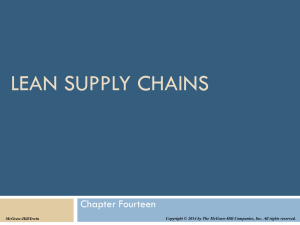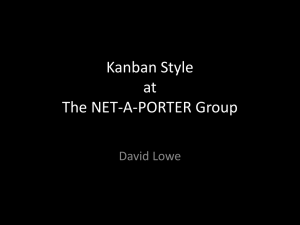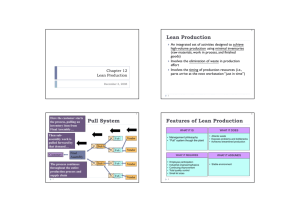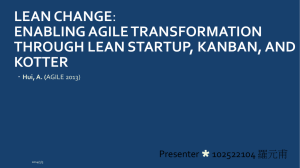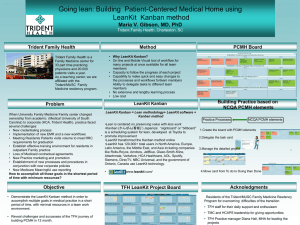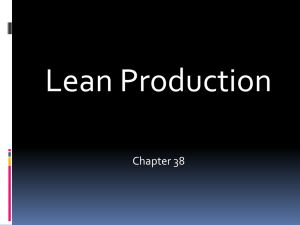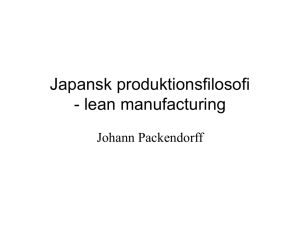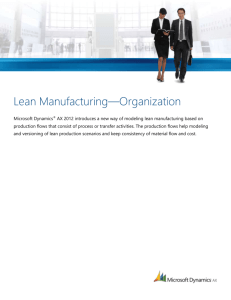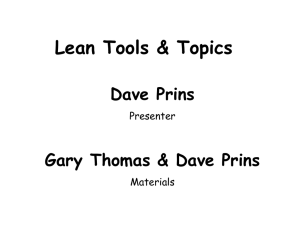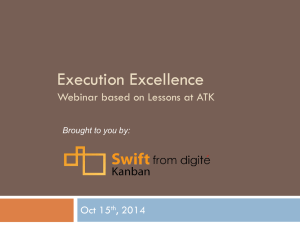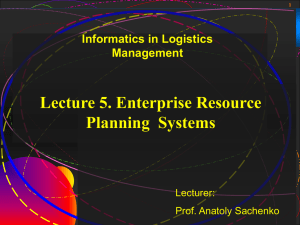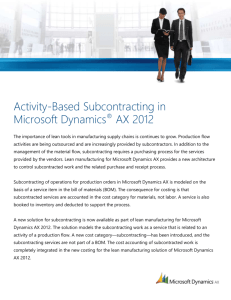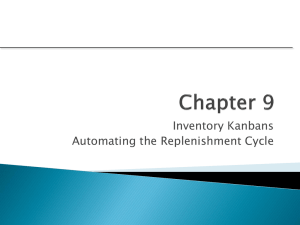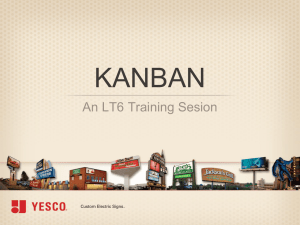PowerPoint
advertisement
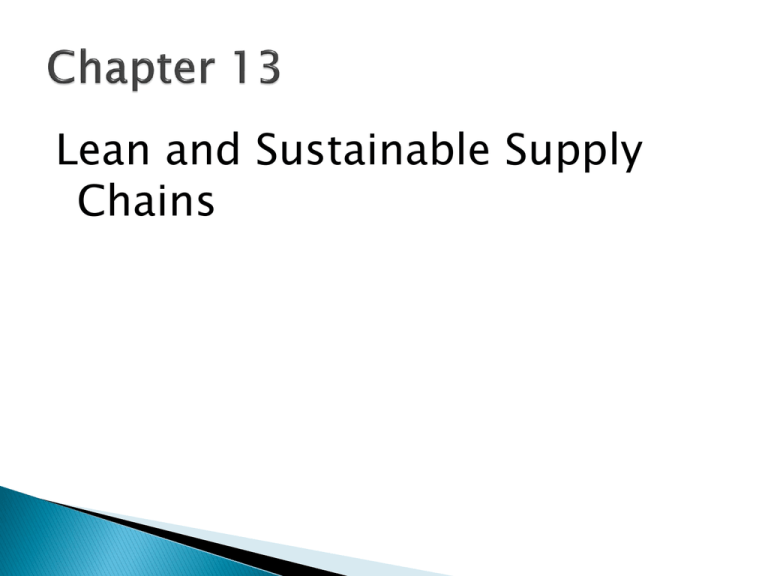
Lean and Sustainable Supply Chains 1. 2. 3. 4. 5. 6. Describe how Green and Lean can complement each other. Explain how a production pull system works. Understand Toyota Production System concepts. Summarize important attributes of a lean supply chain. Analyze a supply chain process using value stream mapping. Know the principles of supply chain design. Lean production: an integrated set of activities designed to achieve high-volume production using minimal inventories (raw materials, work in process, and finished goods) Lean Production also involves the elimination of waste in production effort Lean Production also involves the timing of production resources (i.e., parts arrive at the next workstation “just in time”) LO 1 Value chain: each step in the supply chain should create value ◦ If it does not create value, it should be removed Customer value: something for which the customer is willing to pay Waste: anything that does not add value from the customer’s perspective LO 1 Lean is based on the logic that nothing will be produced until it is needed A sale pulls a replacement from the last position in the system This triggers an order to the factory production line Each upstream station then pulls from the next station further upstream LO 1 Here the customer starts the process, pulling an inventory item from Final Assembly… Then sub-assembly work is pulled forward by that demand… Fab Vendor Fab Vendor Fab Vendor Fab Vendor Sub Customers Final Assembly The process continues throughout the entire production process and supply chain Sub 1. 2. LO 3 Elimination of waste Respect for people 1. 2. 3. 4. 5. 6. 7. LO 3 Waste from overproduction Waste of waiting time Transportation waste Inventory waste Processing waste Waste of motion Waste from product defects Lifetime employment for permanent positions Maintain level payrolls even when business conditions deteriorate Company unions Bonuses View workers as assets LO 3 Value stream: the value-adding and nonvalue-adding activities required to design, order, and provide a product or service Waste reduction: the optimization of the value-adding activities and the elimination of non-value-adding activities LO 4 Lean suppliers ◦ Able to respond to changes ◦ Lower prices ◦ Higher quality Lean procurement ◦ Key is automation (e-procurement) ◦ Suppliers must see into the customers’ operations and customers must see into their suppliers’ operation Lean warehousing ◦ Eliminate non-value-added steps and waste in storage process LO 4 Lean logistics ◦ ◦ ◦ ◦ ◦ ◦ Optimized mode selection and pooling orders Combined multi-stop truckloads Optimized routing Cross docking Import/export transportation processes Backhaul minimization Lean customers ◦ Understand their business needs ◦ Value speed and flexibility ◦ Establish effective partnerships with suppliers LO 4 Value stream mapping: a special type of flowcharting tool for development of lean processes ◦ Used to visualize product flows through various processing steps Need a full understanding of the business including production processes LO 5 LO 5 LO 5 LO 5 Lean layouts 1. a. Group technology b. Quality at the source c. JIT production Lean production schedules 2. a. Uniform plant loading b. Kanban production control system Lean supply chains 3. a. Specialized plants b. Work with suppliers c. Building a lean supply chain LO 6 Plant layout designed to ensure balanced work flow with a minimum of WIP inventory Preventive maintenance is emphasized to avoid downtime ◦ Operators perform much of the maintenance LO 6 Group technology: a philosophy in which similar parts are grouped into families The processes required to make the parts are arranged in a manufacturing cell Eliminated movement and queue time between operations, reduces inventory, and reduces employees LO 6 LO 6 Quality at the source: do it right the first time and if something goes wrong, stop the process immediately Workers become their own inspectors Workers are empowered to do their own maintenance LO 6 JIT production: producing what is needed when needed and nothing more Anything over the minimum is waste Typically applied to repetitive manufacturing Idea lot size is one Vendors ship several times a day JIT exposes problems otherwise hidden by inventory LO 6 LO 6 Level schedule: one that requires material pulled in a pattern uniform enough to allow production to respond to pull signals Freeze windows: that period of time during which the schedule is fixed and no changes are possible Backflush: where parts that go into each unit are periodically removed from inventory and accounted for paged on production Uniform plant loading: smoothing the production flow to dampen the reaction waves that normally occur from schedule variations LO 6 Kanban means “sign” or “instruction card” in Japanese Cards or containers are used Make up the kanban pull system LO 2 Worker takes the first part A from a full container Worker takes the withdrawal kanban from the container, and takes the card to the machine center storage area In machine center, worker finds a container of part A Worker removes the production kanban, and replaces it with the withdrawal kanban ◦ This authorizes the movement of the container to the assembly line The freed production kanban is placed on a rack by the machine center, which authorizes the production of another lot of material ◦ A similar process is followed for part B The cards on the rack become the dispatch list for the machine center LO 2 Once the Production kanban is received, the Machine Center produces a unit to replace the one taken by the Assembly Line people in the first place Machine Center Withdrawal kanban Storage Part A Production kanban The process begins by the Assembly Line people pulling Part A from Storage LO 2 Storage Part A This puts the system back were it was before the item was pulled Assembly Line Material Flow Card (signal) Flow Reductions in setup and changeover times are necessary to achieve a smooth flow Kanban significantly reduces the setup cost The organization will strive for a lot size of one LO 2 LO 6 Specialized plants ◦ Small specialized plants rather than large vertically integrated manufacturing facilities ◦ Can be constructed and operated cheaper Work with suppliers ◦ Important part of process ◦ Share projections with suppliers ◦ Link with suppliers online LO 6 Value must be defined jointly for each product family based on the customer’s perception All firms along the value stream must make an adequate return on their investments Firms must work together to eliminate waste so overall target cost and ROI targets are met When cost targets are met, the firms will conduct new analyses to identify remaining waste and set new targets. Every participating firm has the right to examine every activity relevant to the value stream as part of the joint search for waste LO 6

